|
Not so long ago I came across an article in The Guardian by Richard Osman that took a satirical look at the whole issue of those "hundred things you need to see/do/eat/drink/smell before you die" lists that seem to crop up every few days in one media or another. The idea of such a dig had an instant appeal for me. Mr. Osman has a dry wit that I usually respond to and such lists are always hopelessly subjective anyway. Yet the article in question proved a serious let-down, a substance-thin recycling of old ideas with no new insight, and sorely lacking the sort barbed wit that Charlie Brooker would once have brought to such a piece. Yet nestled within was a probably unintentional but still revealing comment on the mainstream attitude to classic world cinema, as Mr. Osman responded to the BFI's recently compiled list of The 50 Greatest Films of All Time (another subjective call, frankly) by reassuring his readers:
"The only films from the BFI's list that you must watch are Some Like It Hot, The Godfather and Singin' in the Rain. You have my permission to never watch FW Murnau's 1927 masterpiece Sunrise: A Song of Two Humans or Kenji Mizoguchi's Ugetsu Monogatari. Watch them if you want, but you don't have to."
Although presumably intended to be jocular in tone, there's a wearily familiar subtext bubbling away here in that cheerful assurance that you should definitely watch the widely celebrated Hollywood musical, the widely celebrated Hollywood comedy and the widely celebrated Hollywood gangster film, but you might want to give the eighty-six year old silent film a miss and steer clear of that foreign sounding one with the title you don't understand by a director you've never heard of. Stick with what you know. After all, if it's not made in Hollywood, it's not really a movie.
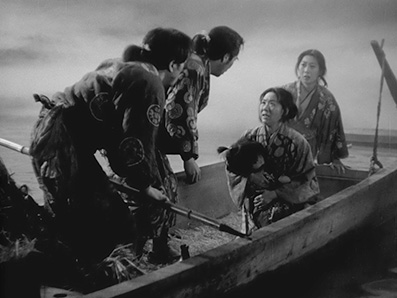
Of course persuading a mainstream audience to watch a downbeat, sixty-year-old Japanese historical drama (with subtitles) has always been like pushing a boulder up the north face of the Eiger. Maybe we shouldn't try. Of course it works both ways. I've heard it suggested more than once that if all the more obscure and so-called 'difficult' films suddenly enjoyed the widespread popularity of their Hollywood cousins, then the cineaste as a breed would be deprived of its purpose and cease to exist. And speaking from experience, I can't help but suspect that if Ugetsu monogatari suddenly became as popular as Star Wars, then a small but significant portion of its previous supporters would suddenly start claiming it was overrated and find another, lesser seen film to champion in its place.
I should state here that I'm not looking to use Mizoguchi's film to dump on those aforementioned Hollywood titles. Singin' in the Rain, Some Like It Hot and The Godfather are all dyed-in-the-wool classics. But so are Sunrise and Ugetsu monogatari, genuinely great films from directors whose careers were distinguished by a number of such works. Clear evidence of this has been provided in the past by Eureka Entertainment, who have repeatedly showcased the work of both directors. Eight of Mizoguchi's film have been particularly well represented, originally released between November 2007 and June 2008 on sumptuously presented DVD double-bills as part of the Masters of Cinema series, then in January 2011 brought together in a single box set titled Late Mizoguchi – Eight Films, 1951-1956, complete with all of the previously included extras. Then in April 2012, two of these double-bills were re-released as dual format editions, with the films and the extra features presented both in standard definition and new HD versions.*
Now Eureka have mirrored on Blu-ray what they did on DVD and released a box set containing all eight of the previously released Mizoguchi films with high definition transfers under the title, once again, Late Mizoguchi – Eight Films, 1951-1956. The films are paired exactly as they were before and with the same extra features, but here both of the films in each set are contained on a single Blu-ray as opposed to the separate DVDs of the earlier release.
As I've already covered each of the films in some detail in my earlier DVD reviews, I'll reproduce the brief summary of each that was provided on the press release for this Blu-ray set and add links to my original reviews.
Oyū-sama (1951) is an adaptation of Tanizaki Jun'ichiro: a poignant tale of two sisters and their ill-fated relationship with the same man: a tale of the social mores and affairs of the heart that might destroy siblings.
Ugetsu monogatari (1953), a ghost-tale par excellence and one of the most highly acclaimed works of world cinema, is an intensely poetic, sublimely lyrical tragedy of men lured away from their wives, a work which consistently features on polls of the best films ever made.
Oyū-sama / Ugestu Monogatari DVD review >
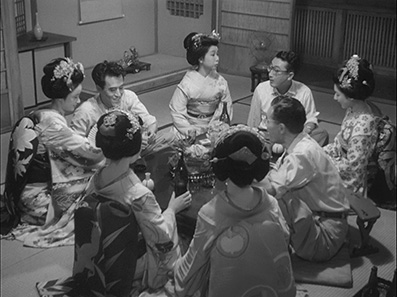
Gion-bayashi (1953) is a drama set in the world of the geisha, a subtle masterwork that yields myriad insights into the lives of Japan's "service-class" in the early '50s.
Sanshō dayū (1954) recounts an unforgettably sad story of the 11th century involving kidnapping and indentured servitude. With its exquisite tone and purity of emotion, it has also become one of the most critically revered films of any era.
Gion Bayashi / Sanshō dayū DVD review >
Uwasa no onna (1954), another Mizoguchi picture set in a modern geisha house, pits mother against daughter, with the ensuing drama forcing both to confront their attitudes toward family and business in what is one of the filmmaker's most astute filmic examinations of oppressed femininity.
Chikamatsu monogatari (1954), the tragic story of a forbidden love affair between a merchant's wife and her husband's employee, was hailed by the legendary Kurosawa Akira as "a great masterpiece that could only have been made by Mizoguchi."
Uwasa no onna / Chikamatsu monogatari DVD review >
Yōkihi (1955) recounts an 8th-century Chinese story of a widowed emperor and his imperial concubine, filmed in sumptuous, hallucinatory Agfa-stock colour.
Akasen-chitai (1956) is Mizoguchi's final masterpiece and one of the greatest last films ever made, depicting the goings-on in a Tokyo brothel carrying the name "Dreamland," where dreams are nevertheless shattered beneath the weight of financial necessity and all questions of conscience – a last testament which inspired the great French critic Jean Douchet to proclaim: "For me, along with Chaplin's Monsieur Verdoux and Renoir's La Règle du jeu, the greatest film in the history of the cinema."
Yōkihi / Akasen chitai DVD review >
All eight films have been given an HD upgrade from their DVD incarnation, and this is the first time that Uwasa no onna, Chikamatsu monogatari, Yōkihi and Akasen-chitai have appeared on Blu-ray anywhere in the world. Although all eight films were the subject of restoration efforts for those earlier DVD releases, the condition of much of the source material was clearly far from ideal. Wear and damage were still frequently evident and the contrast could vary on a scene-by-scene basis, probably to preserve shadow detail that might have been be lost if the black levels were boosted. Given that the same restorations appear to have been used for the both the DVD and Blu-ray editions of the film (I'm not so sure about Yōkihi), the expectation is that the only real difference here will be in the level of visible detail, but that's not the case. Contrast and even brightness have also been fine-tuned in places, bringing some sequences that lacked visual punch on DVD to life without seriously sacrificing detail in darker scenes. It's also worth noting that the higher resolution does also brings the scratches and damage into sharper focus, and despite the best efforts of those concerned, a lot of sometimes very visible wear and tear does remain. For some this may be a problem, but here's how this works – you live with it. And given the sheer quality of the films, their age and former rarity and how good the transfers are in other respects, that's easy to do.
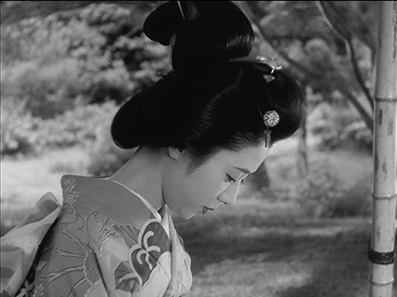
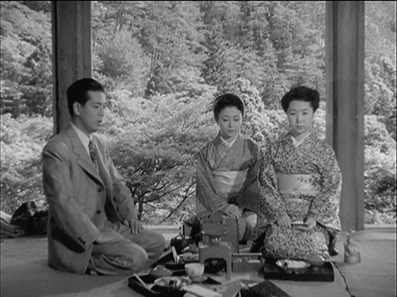
The early daylight scenes in Oyū-sama always looked good on DVD but are even better here, the increased level of detail particularly visible in the background foliage and patterning on kimonos. The picture shift that accompanies some of the dissolves are still here (I would imagine that dissolves, which were created in the optical printing stage, present all a bit of problem for restoration work being done from the original negative), as are the scratches on fades to black and some darker scenes, but much of the film is surprisingly clean and the contrast range is generally fine. There is some variance in the sharpness here, with the crispness of the opening scenes not always evident later in the film, and there are occasionally some more pronounced signs of wear (the white flashes on the left of frame at the start of chapter 10), but this is otherwise a pleasing transfer.
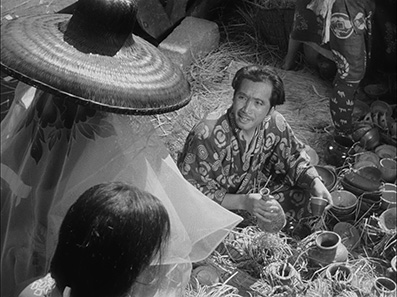
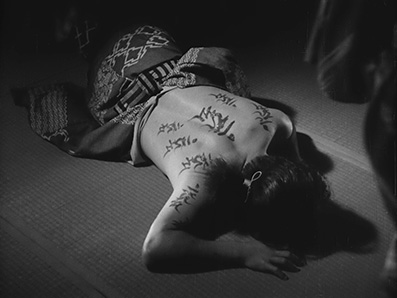
The increased sharpness and detail is immediately apparent on Ugetsu monogatari, something especially visible in exterior wide shots and the textures and the detail of clothing. A good example is the straw hat worn by Lady Wakasa when she buys pottery from Genjuro in the marketplace – the fine detail of the lost in a blur on the DVD but clearly defined on the Blu-ray (you can see screen grab comparisons on my review of the stand-alone Blu-ray of the film here). The image on the Blu-ray is also brighter on some sequences than the previous DVD. This does make the image clearer in darker scenes and give the brighter ones more vibrancy, making some shots on the DVD look a little muddy by comparison. It does, however, raise the question of which of the two is truer to Mizoguchi's original intention, as while the Blu-ray transfer is definitely more attractive, the picture brightening does make a couple of the twilight scenes feel a little more like they are taking place in daylight (see the screen grabs here). This adjustment is not global, however – in terms of its brightness and contrast, the night-time on-sen scene is identical on both discs. The remaining damage is also brought into sharper focus, and there is quite a bit of this, though the worst is confined to some fades to black and a few specific scenes (try the start of chapter 11 or the first post-title wide shot). When the picture shines, however, it really shines.
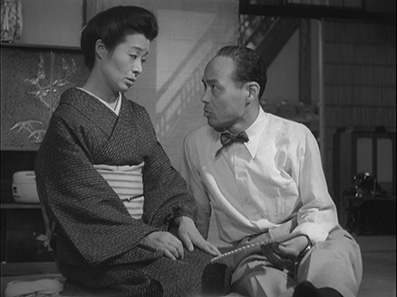
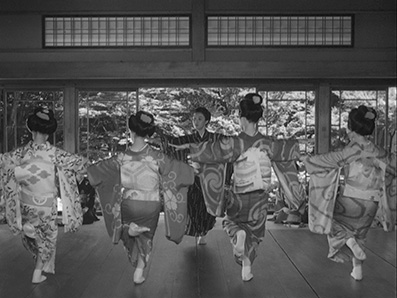
The first thing you notice about the HD transfer of Gion bayashi is that the post-title sequence is nowhere near as washed-out as it looked on DVD – the contrast is still a tad soft to retain the shadow detail, but it feels better balanced, and the high angle wide shot that opens chapter 2, which almost looked bleached on DVD, is considerably better here. Black levels are still grey in darker scenes but are spot-on in daylight, and the visible damage here is surprisingly light. As you would hope, the detail is crisper, something particularly evident on foliage, backgrounds and the detail on kimonos.
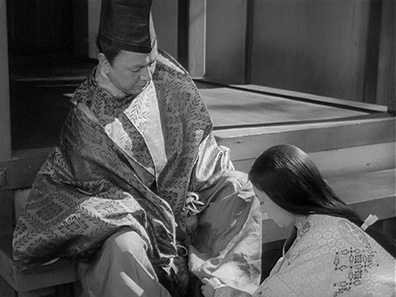
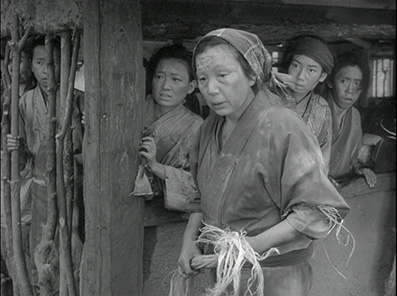
If by some chance you go straight to the start of chapter 2 of Sanshō dayū (and when taking a first peek at the quality of a disc, that's exactly what I'm prone to do) and experience a pang of disappointment at the soft black levels, slight picture flickering and traces of cleaned-up damage, then do yourself a favour and hop forward another chapter to the opening shot of chapter 3, where the excellent contrast, fine detail on the costumes and picture stability will allay your fears. The increased resolution is clearly evident in the wide shots, textured backgrounds and detail on costumes, all three of which are splendidly evident in the shot of a line of straw-roofed huts that opens chapter 8. Occasionally the contrast has been subtly tweaked to give a previously subdued-looking picture more punch, as in the wide shot of the bay that precedes Tamaki's attempt to flee Sado island. Low-key damage issues aside, another strong transfer.
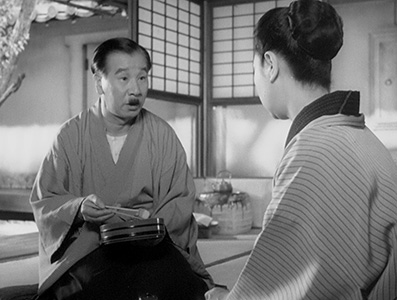
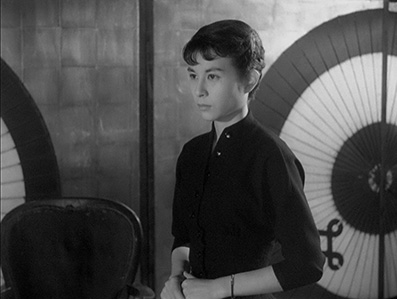
The differences on Uwasa no onna are immediately apparent in the visibly stronger contrast, with the slightly washed-out look of the previous transfer feeling much bolder here. Shadow detail may seem to be lost on some darker areas and clothing, but a quick check reveals that in almost all cases it wasn't there on the DVD either. Some movement of the film in frame from the DVD transfer has also be stabilised, something first visible on the wide shot of Yukiko at the start of chapter 2, an image whose previous jitter has been rendered rock solid. As ever, it's the detail on kimonos that really catches your eye, while old favourites like the clarity of kanji on notices or the numbers on a clock face at the start of chapter 12 (good luck reading them on the DVD) provide the clearest examples of the Blu-ray's increased sharpness. The damage is still there, and the film grain is more prominent here than on most of the other transfers, but this is a definite improvement on the DVD.
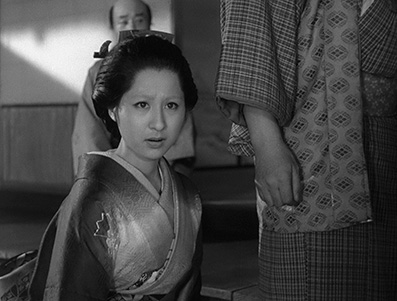
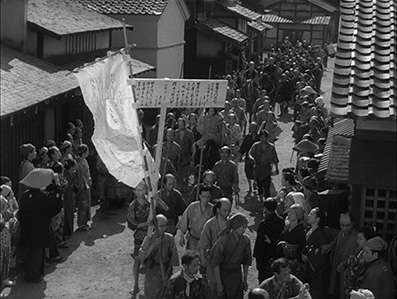
Of all of the Mizuguchi films released on DVD by Masters of Cinema, Chikamatsu monogatari was probably the best looking. Could this new transfer improve on that? You'd better believe it. What was good on the DVD is even better here, with the increased level of detail (and the DVD was good) combining with the small tweaks made to the contrast really bringing the picture to life. The low-level damage and flickering are still there and just occasionally become more pronounced, but on the whole this is a first-rate transfer whose best material is rather lovely.
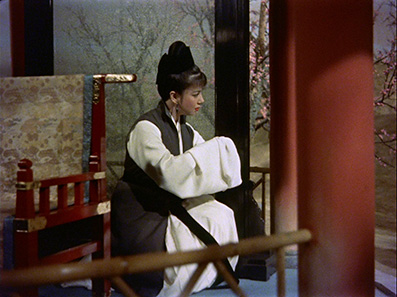
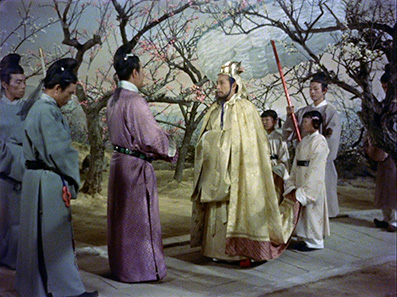
As the only colour film in this set (and one of only two that Mizuguchi shot in colour), I had high hopes for the Blu-ray of Yōkihi, though my enthusiasm was tempered by memories of the condition of the print used for the previous DVD transfer. The problems this presented were evident early on when the Emperor plays a song composed in honour of his late wife, is pestered by his ministers to attend to his duties, and walks off through the palace. On the DVD this sequence was peppered with spots, but here the picture is far cleaner, the contrast punchier and the colour slightly richer. It's also noticeably sharper than the DVD transfer, which better showcases Mizutani Hiroshi's palatial art direction. Some damage remains, and the blue edge-of-frame light leakage is still there, but on the whole this is a marked improvement on the previous DVD.
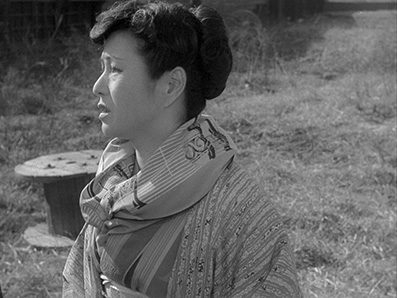
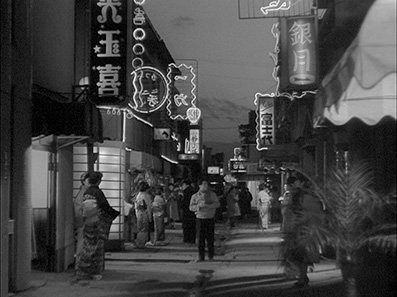
Akasen chitai looked good on DVD but looks even better here, the increased fine detail, together with a clean and stable image and some small contrast tweaks, making it one of the most attractive transfers here and a very close second to Chikamatsu monogatari. It only slips a little during the darker scenes, where the picture flickering that daylight effectively neuters becomes a lot more visible. Otherwise, this is another very fine transfer.
The four films previously released on Blu-ray have DTS-HD Master Audio 2.0 mono soundtracks, the other four have Linear PCM 2.0 mono tracks. Given the age of the films, neither were ever destined to push the capabilities of uncompressed digital audio. Oyū-sama certainly shows its age, with a very narrow range and plenty of background fluff and crackle, though the dialogue is still clear and there is no obvious distortion. Ugetsu monogatari also has its share of background crackle, but it's a lot less pronounced than in Oyū-sama, and the dialogue and music are both clearer and cleaner here. The slight background fluff on Sanshō dayū is about what you'd expect even for a restored film of this age, but there is no problem with clarity and no real damage or noise to contend with. Gion bayashi's soundtrack has a touch more fluff and crackle, and loud noises are sometimes a little shrill, but again it does rather well for its age. Like it's spruced-up picture, the soundtrack of Chikamatsu monogatari is in very good shape, with very little in the way of background hiss and a clear reproduction of dialogue. Traces of crackle are only really evident in the quietest moments or when the picture fades to black. There's also some audible crackle on Uwasa no onna, but it's not there for long and much of the film is free of such blemishes, making it one of the better soundtracks here. As with Chikamatsu monogatari, Akasen Chitai's soundtrack has scrubbed up as well as its picture, with clear reproduction of dialogue and music and the track largely free of background blemishes. The soundtrack to Yōkihi is in surprisingly good shape, though some of the music feels a little forceful if you have the volume up, and the clarity does occasionally vary a little. The background crackle that popped up briefly on the DVD appears to have been eliminated here.
As the extra features have been ported over from the DVD releases, the comments below have been adapted from my reviews of those earlier discs.
Tony Rayns on Oyū-sama and Ugetsu monogatari (12:47 and 8:21)
Two typically interesting introductions from the knowledgeable Mr. Rayns, who usefully provides background detail on both films rather than analysing them. Particularly revealing, given Ugetsu's phenomenal standing, is the information that Mizoguchi was satisfied with neither film, and that Ugetsu won the Silver Lion at the Venice Film festival in a year when no Golden Lion was awarded because the jury didn't see a film that in their opinion deserved it (other films in competition that year, it should be noted, included Fellini's I Vitelloni and Sam Fuller's Pickup on South Street).
Original Japanese trailer for Ugetsu monogatari (3:38)
Showing a lot of damage but intriguing nonetheless, not least for the misleadingly emotive score that at one point plays like that of a rip-roaring adventure tale.
Original Spanish trailer for Ugetsu monogatari (1:08)
An oddly framed scope trailer (the film was shot 1.37:1) that's in surprisingly good shape and blessed with a particularly unexcited voice-over.
Tony Rayns on Mizoguchi, Sanshō dayū and Gion Bayashi (10:12 and 28:03)
A compelling look at Mizoguchi's life and career, with emphasis on his work on the two films in this set. Save for a few cut-aways to photos or posters, this, like the other intros, is a one-shot address to camera, but Rayns is possibly this country's foremost expert on Japanese cinema and is a fountain of fascinating information about the films and their director, and unless you're very well read on Mizoguchi there should be a fair amount that is new here. In total the two introductions here run for a healthy 39 minutes.
Original trailer for Gion Bayashi (3:25)
Plastered with dirt and damage, but this is hardly surprising – I'm amazed the trailer even exists this long after the event. The contrast and detail are still very good.
Teaser trailer for Gion Byashi (2:09)
As above in terms of picture quality, the teaser is of particular interest because it includes some (set up) behind-the-scenes footage.
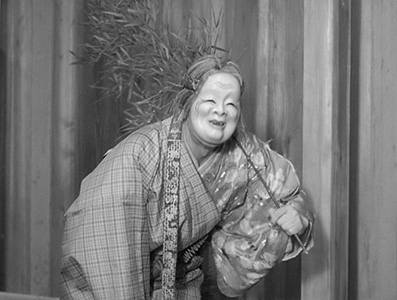
Tony Rayns on Chikamatsu monogatari and Uwasa no onna (13:18 and 12:40)
Tony Rayns provides some useful background on the production of Chikamatsu monogatari, including a detailed biography of Chikamatsu Monzaemon, on whose story the film is largely based. He also fills us in on Mizoguchi's apparent lack of enthusiasm for the project and speculates on the reasons, and clearly regards the film as one of the director's lesser works, a point on which we differ. In his coverage of Uwasa no onna he profiles lead actress Kinuyo Tanaka, with whom Mizoguchi was apparently infatuated, and tells a most interesting story about how the two parted company.
Trailer for Chikamatsu monogatari (3:51)
In similar condition to the trailers mentioned above, one whose opening narration is delivered in the manner of a cheerful TV salesman.
Teaser trailer for Chikamatsu monogatari (2:06)
Again in less than sparkling shape, but does include some brief behind-the-scenes footage and claim that the film is "the acme of cinematic perfection."
Trailer for Uwasa no onna (3:19)
Another rescued trailer that's afflicted with a rainstorm of damage and slightly wobbly sound, but is valuable nonetheless.
Tony Rayns on Yōkihi and Akasen Chitai (9:04 and 11:16)
Another useful pair of intros from Mr. Rayns. In his coverage of Yōkihi he explains the title, provides details of how the production came to be, and how it fared on its release. He's clearly not a fan of the film, indicated by the title card that states "At least it's in colour." There is some crossover of information between the introduction to Akasen Chitai and the commentary below, but there is plenty of information unique to this extra and it is intended as an introduction rather than a full analysis.
Commentary on Akasen Chitai by Tony Rayns
A splendid commentary that's packed to the gills with background detail on the film and the society in which it is set. Mr. Rayns' reading of scenes, characters and Mizoguchi's approach proves a fascinating masterclass in the film's sophistication of theme, character and technique.
Booklet
Booklet? No sir, this is no booklet. It's a fully fledged book, combining the contents of all four booklets from the previous DVD releases into 340 glorious pages of fascinating and often invaluable information on the eight films in this set. What's in it? Try this lot. Opening with a note about the Japanese names and titles (the text employs the Japanese convention of family name first, something I also tend to do), the book proper kicks off with a solid piece on Oyū-sama and a richly detailed essay titled Ugetsu Monogatari: Why Is It a Masterpiece?, both by Keiko I. McDonald. These are supported by translations of The Reed-Choked House and A Serpent's Lust by Ueda Akinari, the two stories on which the script for Ugetsu monogatari was based. Both make for fascinating reading, particularly in context of their adaptation within the film. There's an extract from Mark Le Fanu's 2005 Mizoguchi and Japan that focuses on Gion Bayashi, an extract from a 1937 Kinema Junpo interview with Mizoguchi on his attitudes towards geishas, a 1973 Film Comment article entitled Mizoguchi: The Ghost Princess and the Seaweed Gatherer by Robin Wood, a 2005 essay by Mark Le Fanu on Sanshō dayū comparing the film to the Mori Ōgai's story, and a translation of that very story by J. Thomas Rimer. An extract from Keiko I. McDonald's long out-of-print book Mizoguchi focusses on Uwasa no onna and casts the film as one of the director's lesser works, while Mark Le Fanu's detailed analysis of Chikamatsu monogatari holds the film in higher regard than Tony Rayns, describing it at one point as "beautiful and classically crafted". Le Fanu also provides a breakdown of some of the differences between the film and the play (a running commentary I received on my first viewing with a Japanese friend), as well as persuasive support for the film's unique strengths. You can then make your own comparisons to the source material with the aid of English translations of Ihara Saikaku's 1686 What the Seasons Bought the Almanac Maker and the opening section of Chikamatsu Monzaemon's The Almanac of Love. A further extract from Le Fanu's Mizoguchi and Japan focuses on Yōkihi , which is also explored by Nakagawa Masako in a 1998 article titled Yōkihi: The Film and Legend. This is followed by the poem Ch'ang hen ko (A Song of Unending Sorrow) by Po Chii-i, which was the key inspiration this particular film. A further extract from Keiko I. McDonald's book Mizoguchi explores Akasen Chitai in enthralling detail, and there are a collection of sincere tributes to the filmmaker, which are headlined by his own self-penned death poem. As you would expect, there are also a number of high quality stills, credits for all eight films, and notes on how to view them correctly. Seriously, you'd happily pay good money for this book were it a stand-alone purchase. Just superb.
For fans of the cinema or Mizoguchi Kenji – and quality cinema in general – this is a bit of a dream package, eight major works by one of world cinema's finest directors, all looking better than ever on Blu-ray and backed by some fine extra features, including an epic accompanying booklet (sorry, book). For most it will be a must-have set, albeit one you may have to save up for (stick it on your Christmas list if you are prone to such things). If you've already paid out for the dual format releases of Ugetsu monogatari and Sanshō dayū, however, you'll already have half of the films here in their HD incarnation and might be just a little bit miffed at having to cough up for them again to get the other four films in this set. It's a valid complaint, but for those who own none of the films already or only picked up a couple of the DVDs, the decision should be easy. Highly recommended.
* This one confused me when preparing this review, as while I covered the dual format release of Ugetsu Monogatari and Oyū-sama, I somehow completely failed to do likewise with Sanshō dayū and Gion bayashi. I'm still at a loss to work out why, and thus found myself searching stubbornly for the review I was convinced I had written, like I'd lost my house keys and was sure I would find them somewhere inside my computer.
|